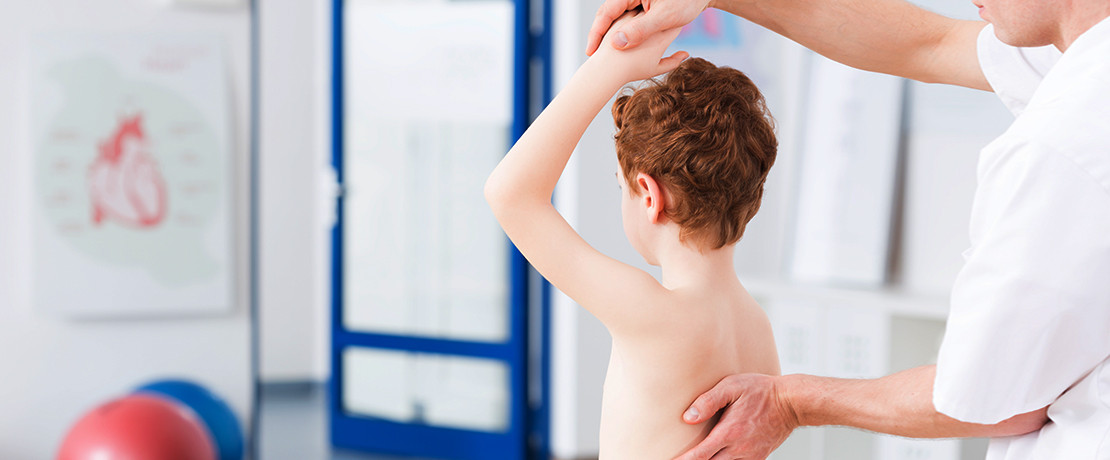Unlike fever, which produces obvious symptoms, children with scoliosis generally do not exhibit any symptoms unless the curve of the spine is severe. Scoliosis can be found in newborn babies up until teens, although it is much more common in teens. While there are many causes of adolescent scoliosis, the exact origin of the condition is unknown in about 80% of patients. Genetic predisposition may contribute and it can run in families, so a child may have a brother or sister with the condition. In some families, an only child can be found with congenital scoliosis. According to research findings, scoliosis requiring treatment occurs in 1 in 10,000 Thai children. However, there are also lot of children with mild scoliosis that do not need treatment. During these days, the condition is more frequently found in children because parents pay more attention to their children and there is an increase in the number of orthopedics specialists who will detect the deformity sooner rather than later.
Scoliosis can be categorized into different types:
- A straight spine which develops a curve later in life. The cause in such cases is generally unknown, but it may be associated with hormones that control the nervous system responsible for maintaining balance causing the spine to curve. This type of scoliosis accounts for approximately 80% of cases. It is categorized into 3 age groups.
- From birth – 1 year old: This occurs as children are beginning to stand and walk, and 90% of these children will self-resolve as they grow.
- From 3-10 years old: There is an increase in the number of patients in this age range. If the curve is severe and not treated, the children will develop long-term problems.
- From 10-18 years old: Scoliosis occurs most commonly during adolescence. Mild scoliosis generally does not need treatment. Frequent checkups by a doctor are advised because the curve may become more pronounced and abnormal, thereby causing impaired physical development. The doctor will measure the curve in degrees. Below 15 years of age, if the curve is somewhere between 30-40 degrees, the doctor will advise the patient to wear a scoliosis brace to improve the curvature of the spine. However, if the scoliosis becomes progressively worse, surgery will be required involving metal implants being inserted to keep the spine aligned.
- Scoliosis which is present at birth with an unknown cause. This may be caused by medication taken by the mother during pregnancy. It is a result of bone abnormalities such as imbalance in the growth of the spine. Such scoliosis curves can worsen very quickly and require immediate medical attention because if they become severe, they can cause paralysis.
- Scoliosis which develops as children grow due to some abnormality in the nervous or muscular systems such as brain disorders, cerebral palsy, polio, muscular disorders, etc.
- Scoliosis usually occurs in 30% of people with neurofibromatosis, which is often seen as raised bumps and/or brown spots on the body.
Parents can check their children’s spine to see if they have signs of scoliosis. The examination requires the child to stand erect so as to check for any curvature in the spine. Next, ask the child to bend forward with hands touching the floor and check for any curvature of the spine. If the spine looks straight, it is normal. However, parents should seek medical attention for diagnosis and follow-up so as to evaluate whether the symptoms will worsen over time if any of the following signs are observed:
- Any curvature in the spine
- Uneven shoulder levels, with one shoulder blade protruding more than the other
- Head not centered directly above pelvis
- One hip higher than the other
- Uneven rib cages
- Uneven waist creases
- Appearance of different skin conditions from another side of the body, such as dimples, hairy patches, colour abnormalities
- Entire body leaning to one side
Scoliosis during adolescence which remains untreated will get progressively worse and cause significant health problems such as tilted body, lowered shoulder, tilted waistline, physical disability, back pain, breathing problems, pant, pneumonia, lung infections, and causing the heart works too hard which may lead to heart failure.
Scoliosis can be categorized into different types:
Scoliosis Diagnosis
In addition to looking for any abnormal conditions, the doctor will also check the nervous system. Radiographic tests may be required for more detailed diagnosis and evaluation so as to determine the severity of the disease and assess the bone age of patients.
Treatment Options
- Non-surgical treatment: In case of mild curvature, no treatment is required other than monitoring, physical therapy or bracing.
- Surgical treatment: If the curve gets progressively severe or worsens during follow-up of conservative treatment, surgical treatment is required.
Physical therapy: This approach involves adjusting sleeping and physical positions, as well as appropriate exercises to restore the spinal balance or attain its nearest alignment. Specific treatment varies according to each individual case. However, the treatment should be performed under the supervision of a trained therapist for maximum efficiency
Samitivej’s New Life Fund
Samitivej’s New Life Fund was established to provide underprivileged children with access to high quality surgical treatments. Through the generous donations of the foundation and the hard work of our doctors, children suffering from scoliosis have the opportunity to receive treatment and grow up to be strong, healthy adults.
In honor of His Majesty The King’s 88th birthday in 2016, Samitivej’s New Life Fund also aims to perform eight surgeries on underprivileged children suffering from scoliosis.
Learn more about Samitivej’s New Life Fund here.
